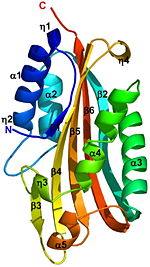Insecticidal delta-endotoxin Cyt2Ba from Bacillus thuringiensis
From Proteopedia
High-resolution crystal structure of activated Cyt2Ba monomer (δ-endotoxin) from Bacillus thuringiensis subsp. israelensis
Publication Abstract from PubMed
The Cyt family of proteins consists of delta-endotoxins expressed during sporulation of several subspecies of Bacillus thuringiensis. Its members possess insecticidal, hemolytic, and cytolytic activities through pore formation and attract attention due to their potential use as vehicles for targeted membrane destruction. The delta-endotoxins of subsp. israelensis include three Cyt species: a major Cyt1Aa and two minor proteins, Cyt2Ba and Cyt1Ca. A cleaved Cyt protein that lacks the N- and C-terminal segments forms a toxic monomer. Here, we describe the crystal structure of Cyt2Ba, cleaved at its amino and carboxy termini by bacterial endogenous protease(s). Overall, its fold resembles that of the previously described volvatoxin A2 and the nontoxic form of Cyt2Aa. The structural similarity between these three proteins may provide information regarding the mechanism(s) of membrane-perforating toxins. High-resolution crystal structure of activated Cyt2Ba monomer from Bacillus thuringiensis subsp. israelensis., Cohen S, Dym O, Albeck S, Ben-Dov E, Cahan R, Firer M, Zaritsky A, J Mol Biol. 2008 Jul 25;380(5):820-7. Epub 2008 May 11. PMID:18571667 From MEDLINE®/PubMed®, a database of the U.S. National Library of Medicine. The crystal structure of the proteolytically activated monomeric form of Cyt2Ba was determined at 1.8Å resolution. It consists of a single domain of α/β architecture with a β-sheet (yellow) surrounded by 2 α-helical layers (red) forming a cytolysin fold. The β-sheet is comprised of 6 anti-parallel β-strands (β1-β6). On one side of this sheet there is an α-helix layer consisting of α1, α2; and on the other side a second α-helix layer, composed of α3-α5. The β-strands β2-β5 of the central β-sheet have a modified Greek-key topology. The Greek key motif consists of four adjacent antiparallel strands and their linking loops. It consists of three antiparallel strands connected by hairpins, while the fourth is adjacent to the first and linked to the third by a longer loop [1]. Cyt2Ba (gray) has only 16% sequence identity with VVA2 (colored red, 1pp0), however they both have a cytolysin fold and their overall structure is very similar (see their structural alignment). A remarkable similarity is observed between the structures of the endogenously cleaved Cyt2Ba monomer (gray) and the corresponding region (red) within the inactive protoxin dimer of Cyt2Aa (1cby, monomers A and B of Cyt2Aa shown red and blue, respectively, the N- and C-termini are shown in spacefilling representation). Although, 1cby is a 1 chain structure, the biological relevant molecule for 1cby can be assembled from the contents of the deposited coordinates by the application of crystallographic symmetry operations to give a dimer. It can be downloaded. Each monomer of Cyt2Aa (1cby), consists of an additional β-strand at its N-terminus and an additional α-helix at its C-terminus compared to the cleaved Cyt2Ba. The dimer interface of Cyt2Aa is held together by the intertwined N-terminal strands from both monomers. The cleavage of Cyt2Aa removes the N- and C-terminal segments, prevents dimer formation and releases an active toxin monomer. Similarly, in Cyt2Ba the proteolysis causes the removal of 34 amino acids at its N-terminus and 28 or 30 residues at its C-terminus forming the crystallized toxic monomer. ConclusionsThe crystal structure of monomeric Cyt2Ba is the first structure of a toxic form of the Cyt family. Its structure is homologous to the corresponding region of Cyt2Aa and to that of VVA2. This structural comparison shows that the toxicity of Cyt2Ba, Cyt2Aa and VVA2 is an inherent property of the monomer and not the result of secondary structure rearrangement upon cleavage. Solving the 3D structure of these proteins extends the knowledge of the cytolytic machinery of pore-forming toxins and helps in designing novel membrane-active cytotoxins. |
| ||||||||||
3D structures of δ-endotoxin
Additional Resources
For additional information, see: Toxins
Reference
High-resolution crystal structure of activated Cyt2Ba monomer from Bacillus thuringiensis subsp. israelensis., Cohen S, Dym O, Albeck S, Ben-Dov E, Cahan R, Firer M, Zaritsky A, J Mol Biol. 2008 Jul 25;380(5):820-7. Epub 2008 May 11. PMID:18571667
Proteopedia Page Contributors and Editors (what is this?)
Alexander Berchansky, Joel L. Sussman, Eran Hodis, Jaime Prilusky, Michal Harel, David Canner, Eric Martz
Categories: Bacillus thuringiensis serovar israelensis | Single protein | Dym, O. | ISPC, Israel Structural Proteomics Center. | Alpha/beta architecture with beta-sheet surrounded by two alpha-helix layer | ISPC | Israel Structural Proteomics Center | Plasmid | Sporulation | Structural genomic | Toxin


